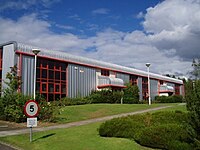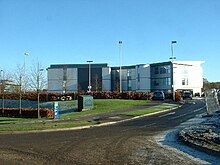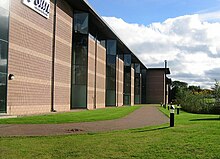Silicon Glen

Silicon Glen is the nickname given to the high tech sector of Scotland, the name inspired by Silicon Valley in California. It is applied to the Central Belt triangle[1] between Dundee, Inverclyde and Edinburgh, which includes Fife, Glasgow and Stirling; although electronics facilities outside this area may also be included in the term. The term has been in use since the 1980s. It does not technically represent a glen as it covers a much wider area than just one valley.
History

Silicon Glen had its origins in the
The emphasis on electronics came about due to the decline in traditional Scottish heavy industries such as shipbuilding and mining. The government development agencies saw electronics manufacturing as being a positive replacement for people made redundant through heavy industry closures and the associated training and reskilling was relatively easy to achieve.
Like the bedrock of
In 1970, Compugraphic relocated from Aldershot to Glenrothes to provide photomask manufacturing for these companies. Other companies who developed semiconductor wafer fabrication or other manufacturing plants included SGS in Falkirk, NEC, Burr-Brown Corporation, IPS (then Seagate Technology) and Kymata (now Kaiam) in Livingston, CST in Glasgow and Micronas in Glenrothes.
There were some other notable successes such as the large
The potential and implications of a single European market motivated foreign companies, particularly those from the United States, to establish operations in Silicon Glen. By having a presence in a European Economic Community member country, companies could formally participate in standards committees and thus exert a degree of influence. Emerging European tariff rules concerning the origin of products were also strong motivators for the establishment of local manufacturing operations, with the EEC having updated its rules in 1989 to consider the location of the wafer diffusion phase of semiconductor production as determining the origin of the manufactured product. Local infrastructure support for the semiconductor industry was well regarded in Scotland, with local universities offering "a strong design base".[4]
and others.The manufacturing sector grew to such an extent that at its peak it produced approximately 30% of Europe's PCs, 80% of its workstations, 65% of its ATMs and a significant percentage of its integrated circuits.[5]
Today


The heavy dependency on electronics manufacturing hit Silicon Glen hard after the collapse of the hi-tech economy in 2000. Viasystems,
However, there are many promising signs as well as a recognition that diversification away from electronics and manufacturing produces a more balanced and stronger economy. There is also more of an interest in encouraging home grown talent.
To diversify away from electronics and manufacturing, the development agencies now see global services as being a potential area of growth, but there is also substantial interest in the software development industry, including
In addition to the indigenous companies, Silicon Glen continues to have quite a significant semiconductor design community of inward investment companies including
Semefab, the former
Scotland had 1,000 companies in electronics employing 25,000 people in 2004, this number has been in decline since 2000 when 48,000 people were employed in the industry in Scotland.[7] However, by 2016 the Silicon Glen has begun to boom once again, with new digital start ups - such as Skyscanner - choosing Scotland for headquarters or offices.
The Open Source Awards (formerly the Scottish Open Source Awards) have been run from Scotland since 2007.[citation needed] It was initially a subset of the Scottish Software Awards.
Notable companies
Many high technology companies are established in Silicon Glen, including:
- Unity (game engine)
- Microsoft
- Amazon.com
- Codeplay
- FanDuel
- IBM
- Oracle Corporation
- Rockstar North
- Adobe Systems
- Canon Medical Systems Corporation
- Skyscanner
- Motorola
- NCR
- Proper Games
- Raytheon
- Texas Instruments
- Freescale
- 3Com
- Agilent
- Analog Devices
- Atmel
- Atos
- Axeon
- ST Microelectronics
- Broadcom Corporation
- Cadence Design Systems
- Cirrus Logic
- Dialog Semiconductor
- Dynamo Games
- IndigoVision
- Thales Optronics
- Toshiba Medical Visualization Systems
- Version 1[8]
- Linn
- Maxim Integrated Products
- Memex Technology Limited
- Micrel
- Braindead Ape Games
- Micronas Intermetall[9]
- Leonardo MW Limited[10]
- Semefab[11]
- Allegro MicroSystems
- AND Digital[12]
- Waracle[13]
- WFS Technologies
- ATEEDA
- Codestuff
- Compugraphics[14]
- ClinTec International
- Clyde Space
- Infinity Works[15]
- Youmanage
- Digital Goldfish
- Kaiam Europe limited
- MEP Technologies Ltd
- Brand Rex[16]
- Elonics
- Kumulos[17]
- Optos
- Micro Linear
- BI Technologies[18]
- Mage Control Systems Ltd[19]
- CRC Group[20]
- Shin Etsu Handotai Europe Ltd
See also
- List of places with 'Silicon' names
References and notes
- ^ "National semiconductor strategy". GOV.UK. Secretary of State for Science, Innovation and Technology. 19 May 2023. Retrieved 12 December 2023.
- ^ Grossman, Wendy M. (September 1993). "Northern Exposure". Personal Computer World. pp. 294–296, 298.
- ^ DeTar, Jim (9 January 1995). "Motorola To Take Over Digital's Scottish Plant". Electronic News. pp. 1, 4. Retrieved 10 June 2022.
- ^ Miller, Christine (June 1990). "Silicon Glen: The European Challenge". IEEE Micro. pp. 7–8. Retrieved 19 March 2023.
- ^ "Vaz, Keith (2001). Success of British companies in the rest of Europe" (PDF).
- ^ "155 Scots jobs lost since Sun takeover by Oracle". The Scotsman. 10 March 2011. Retrieved 25 December 2016.
- ^ Council, Fife (13 October 2021). "Home". www.fife.gov.uk. Retrieved 24 October 2021.
- ^ "Home". Version 1.
- ^ "Micronas Home | micronas.com". www.micronas.com.
- ^ "Home - Leonardo in the UK". www.uk.leonardocompany.com.
- ^ "Semiconductor and MEMS Fabrication". Semefab.
- ^ "New Edinburgh Office Opens - AND Digital". AND Digital.
- ^ "Mobile App Development | Scotland, UK". Waracle.
- ^ "Compugraphics". Compugraphics.
- ^ "Software consultancy Infinity Works opens in Edinburgh's WeWork site". Scotsman. 23 October 2019.
- ^ "Brand Rex".
- ^ "Mobile App Performance Management for Developers ¦ Kumulos". Kumulos.
- ^ "Electronics | Sensors, Power, Connectivity & Manufacturing Solutions | TT Electronics". www.ttelectronics.com. 26 November 2018.
- ^ "Mage Control Systems Ltd - Creative Control Systems". 16 May 2019.
- ^ CRC Group
External links
- Scotland IS, the trade body for the Scottish IT sector
- Pico and General Instrument's 1970 development of a single chip calculator processor chip Possibly pre-dating Intel and TI.
- The death and rebirth of Silicon Glen BBC News
- Open Tech Calendar, free and open list of tech events in Scotland
